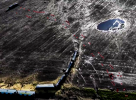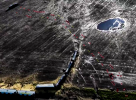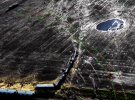Because we are coming here to doubt on damage indicators, I'm going to come and cast doubt on Chapman 2016 as well. But is it that impressive to bend train tracks? I'm assuming considering how metal can have a wide variety of strength based on thermal factors that depending on the condition of the metal of the tracks and temperatures preceding the event this could result in a wide variety of winds that could bend it. Apparently track buckling is a very big and common problem with tracks anyways to begin with.
Navigation
Install the app
How to install the app on iOS
Follow along with the video below to see how to install our site as a web app on your home screen.
Note: This feature may not be available in some browsers.
More options
-
Welcome to TalkWeather! We see you lurking around TalkWeather! Take the extra step and join us today to view attachments, see less ads and maybe even join the discussion. CLICK TO JOIN TALKWEATHER
You are using an out of date browser. It may not display this or other websites correctly.
You should upgrade or use an alternative browser.
You should upgrade or use an alternative browser.
Union
Member
Mud splattering of everything isn't a quality to only EF5 tornadoes, but its prevalent in almost all of them because they are strong, but any tornado can splatter everything it touches in dirt and mud especially when that's basically the only ground type it's hitting for miles on end. Shrub once again was pounded by 2 rail tankers and then also covered in mud, I do think the trees in the area could fit a tornado of the strength pretty well, just not in the 260mph caliber of EF5, also about the need to rate tornadoes accurately rather than according to past examples, I agree, but I think it would be a very strange decision to leave this as a one off situation in a sea of tornadoes that have moved theses larger objects, that is just something we'll have to wait and see on as more and more tornadoes happen because over the coming years, hopefully the revised EF scale too soon lolI'm saying it should be EF5. The need to rate tornadoes accurately holds priority over consistency with the recent past.
Everything else lines up with enderlin being an EF5 calibre tornado in that area. The extreme plastering of mud and stubble. The mangled shrub. The windowed grain. The magnitude of the weight of those cars being dragged and likely lofted. The calculations were done. The fact nothing came up that would dispute such an unlikely Upgrade, cements it for me.
Enderlin is a certified EF5 and rightfully should be.
Larger does not necessarily mean they weren't easier to move. Shape can have a lot of influence on whether things can be lofted/thrown as well lets not forget.Mud splattering of everything isn't a quality to only EF5 tornadoes, but its prevalent in almost all of them because they are strong, but any tornado can splatter everything it touches in dirt and mud especially when that's basically the only ground type it's hitting for miles on end. Shrub once again was pounded by 2 rail tankers and then also covered in mud, I do think the trees in the area could fit a tornado of the strength pretty well, just not in the 260mph caliber of EF5, also about the need to rate tornadoes accurately rather than according to past examples, I agree, but I think it would be a very strange decision to leave this as a one off situation in a sea of tornadoes that have moved theses larger objects, that is just something we'll have to wait and see on as more and more tornadoes happen because over the coming years, hopefully the revised EF scale too soon lol
Union
Member
Well debris debarks trees, that's known, it's incredibly difficult for wind to just peel it off by itself because there's no way to get under the bark naturally without something starting the reaction, and anything can be used as a projectile to tear off bark in a tornado, small rocks and stones even, debarking isn't even being continued into the revised EF scale DIs because of its inconsistency, there have been completely debarked trees next to EF2 homes before and trees not debarked at all in areas of clear EF5 intensity tornadoes.Nobody knows what winds are required to debark trees. Attaching wind speeds to it is just speculation. For all we know it requires 300 mph winds to entirely debark trees. The only way to estimate it is by association to other tornadoes that produced the same damage, and it's safe to say the accepted understanding of high end tornado wind speeds has come highly into question over the last few years.
the markings of the other derailed tankers are straight on without skipping, those were shoved/pulled through the mud without being lofted at all
They were also connected, and had a collective weight of 500k-600k pounds so them being drug instead of lifted is plausible. Something that can drag 500,000 pounds 90 degrees, can easily loft something that weighs 77,000 pounds.
There are no "tracks" for the large majority of the distance on the tanker car. The "tracks" that were found are so faint they can only be seen from certain angles and lighting. The gouges are very likely impact craters. How would you explain the compressed ends if not from a collision with the ground?
Union
Member
I didn't mean larger as in objects in the past moved were larger, though it has happened, I just mean larger objects as a blanket term, for large trucks, railcars, liquid tanks, I mean even haybales count according to the Miller et al. paperLarger does not necessarily mean they weren't easier to move. Shape can have a lot of influence on whether things can be lofted/thrown as well lets not forget.
tornado examiner
Member
Be enderlin. Get rated EF3 based on tree’s and destroyed homes. One guys makes calculations on you, you seem impressive. But everyone ignores you anyways and eventually forgets you happened except for those who were there.
3 months later, you get rated EF5, everyone is shocked, surprised and impressed. It's a great day for science.
7 days later, everyone starts questioning you again. This time saying you’re not as impressive as initially thought since your upgrade.
Nobody can make heads or tails of your feats.
And the science is also called into question.
(were you actually worthy of EF5?)
3 months later, you get rated EF5, everyone is shocked, surprised and impressed. It's a great day for science.
7 days later, everyone starts questioning you again. This time saying you’re not as impressive as initially thought since your upgrade.
Nobody can make heads or tails of your feats.
And the science is also called into question.
(were you actually worthy of EF5?)
Tracks bending is the result of thermal buckling from extreme heat. It was only 85 degrees in Chapman that day. I will say it could've been intense friction that resulted in the tracks heating up and buckling, but that friction would still be evidence of extremely intense winds.Because we are coming here to doubt on damage indicators, I'm going to come and cast doubt on Chapman 2016 as well. But is it that impressive to bend train tracks? I'm assuming considering how metal can have a wide variety of strength based on thermal factors that depending on the condition of the metal of the tracks and temperatures preceding the event this could result in a wide variety of winds that could bend it. Apparently track buckling is a very big and common problem with tracks anyways to begin with.
Union
Member
The tracks aren't very visible from most areas because the entire area looks the same, it's indiscernable mud from a lot of angles because there's nothing there to help show any holes, especially when they are scattered and not continued like in the case of the car displaced a long distance, that's why I mention how much easier it'd be if this was a full crop field. The crushed ends though I could see as the car being lifted up periodically, for a very short amount of time and very short amount of distance before hitting the ground again, that's why the marks skip places instead of being one straight line, I couldn't tell you how long it would've taken for the tanker to travel the distance but it rolling on all sides, them hitting the ground over and over I could see definitely pushing it in more on the ends. Also if it were lofted a long distance, for it to be crushed on both ends, which I recall it being, it would've had to smack the ground at least twice in the distance it was displaced, so it wouldn't have been lofted the whole distance anyways, but that's kinda irrelevant because the distance was incredibly far.They were also connected, and had a collective weight of 500k-600k pounds so them being drug instead of lifted is plausible. Something that can drag 500,000 pounds 90 degrees, can easily loft something that weighs 77,000 pounds.
There are no "tracks" for the large majority of the distance on the tanker car. The "tracks" that were found are so faint they can only be seen from certain angles and lighting. The gouges are very likely impact craters. How would you explain the compressed ends if not from a collision with the ground?
Union
Member
Also when I say rolling, I don't mean like rolling a can on the floor, it definitely seems like it was bouncing a good bit but never really being lofted high enough to not touch the ground somewhere, I could say bouncing instead but I also think that could be misleading, honestly it would've been even even better if the railcar hit in this scenario wasn't already a circle so that we could see how deformed it got from its original shape lmaoThey were also connected, and had a collective weight of 500k-600k pounds so them being drug instead of lifted is plausible. Something that can drag 500,000 pounds 90 degrees, can easily loft something that weighs 77,000 pounds.
There are no "tracks" for the large majority of the distance on the tanker car. The "tracks" that were found are so faint they can only be seen from certain angles and lighting. The gouges are very likely impact craters. How would you explain the compressed ends if not from a collision with the ground?
Steel retains heat really well and can be up to 20 degrees Celsius hotter than the air around it. Not to mention if there had been recent trains recently cross friction could've been from that. Then you have to factor in the exact composition of the steel as well. There are a lot of factors that would lead to the underlying uncertainty of windspeed bending a small section of track would require. Inversely, one of the more famous damage feats of damage of the Tri-State tornado was that train tracks were torn out of the ground, but that tornado occurred in March early in the year and cold weather actually makes tracks more brittle so the tracks could've been thermally weakened before it occurred.Tracks bending is the result of thermal buckling from extreme heat. It was only 85 degrees in Chapman that day. I will say it could've been intense friction that resulted in the tracks heating up and buckling, but that friction would still be evidence of extremely intense winds.
Union
Member
Another interesting thing about Enderlin is the house that got upgraded to 180, at least from my knowledge, has no mention of the trees around the home supporting a contextual upgrade nor do any of the trees around the house have DIs, but the house was terribly built with 0 anchoring at all, how does that just randomly get bumped up 20mph?Be enderlin. Get rated EF3 based on tree’s and destroyed homes. One guys makes calculations on you, you seem impressive. But everyone ignores you anyways and eventually forgets you happened except for those who were there.
3 months later, you get rated EF5, everyone is shocked, surprised and impressed. It's a great day for science.
7 days later, everyone starts questioning you again. This time saying you’re not as impressive as initially thought since your upgrade.
Nobody can make heads or tails of your feats.
And the science is also called into question.
(were you actually worthy of EF5?)
Tumbling end over end is much different than rolling on its side. It also was a muddy field so you'd think the sides and top of the car would be more muddy if it had rolled. Both ends were caked with mud. There were only 4 impact craters over the whole distance. The car was basically lofted 100 yards 4 seperate times.The tracks aren't very visible from most areas because the entire area looks the same, it's indiscernable mud from a lot of angles because there's nothing there to help show any holes, especially when they are scattered and not continued like in the case of the car displaced a long distance, that's why I mention how much easier it'd be if this was a full crop field. The crushed ends though I could see as the car being lifted up periodically, for a very short amount of time and very short amount of distance before hitting the ground again, that's why the marks skip places instead of being one straight line, I couldn't tell you how long it would've taken for the tanker to travel the distance but it rolling on all sides, them hitting the ground over and over I could see definitely pushing it in more on the ends. Also if it were lofted a long distance, for it to be crushed on both ends, which I recall it being, it would've had to smack the ground at least twice in the distance it was displaced, so it wouldn't have been lofted the whole distance anyways, but that's kinda irrelevant because the distance was incredibly far.
tornado examiner
Member
Idk ask the surveyors at this point. That's the only way we’ll get solid answers.Another interesting thing about Enderlin is the house that got upgraded to 180, at least from my knowledge, has no mention of the trees around the home supporting a contextual upgrade nor do any of the trees around the house have DIs, but the house was terribly built with 0 anchoring at all, how does that just randomly get bumped up 20mph?
I know we like to harp on about certain surveyors having absolutely zero clue what they’re doing but nws grand forks seems to know.
Unless they were being too generous and the EF5 drought really will never end.
Union
Member
From what I've seen/heard, Chapman seems to be the most outstanding example of the very rare "railroad track damage", all the other examples of torn up or bent tracks, which I know of at least 3 others including Tri State, were insanely debris loaded in the areas the tracks were bent or destroyed, at least from what we know Chapman didn't hit the tracks with anything except wind and ballast, maybe a car to be real tho because it was an insane tornado, and it still shoved 300ft of it off the center of the ballast it was laying on.Steel retains heat really well and can be up to 20 degrees Celsius hotter than the air around it. Not to mention if there had been recent trains recently cross friction could've been from that. Then you have to factor in the exact composition of the steel as well. There are a lot of factors that would lead to the underlying uncertainty of windspeed bending a small section of track would require. Inversely, one of the more famous damage feats of damage of the Tri-State tornado was that train tracks were torn out of the ground, but that tornado occurred in March early in the year and cold weather actually makes tracks more brittle so the tracks could've been thermally weakened before it occurred.
Union
Member
I don't think u can send embed videos here i could be wrong, these are all screenshots from the video I'm looking at outlining a path of impact marks, credits to TornadoTRX on X/TwitterTumbling end over end is much different than rolling on its side. It also was a muddy field so you'd think the sides and top of the car would be more muddy if it had rolled. Both ends were caked with mud. There were only 4 impact craters over the whole distance. The car was basically lofted 100 yards 4 seperate times.
Attachments
For all the doubt being cast on Enderlin I will note that the official rating of Enderlin is 210 MPH well under the potential 266 for the thrown/tumbled rail car. Which probably gives a really big buffer for Enderlin to be downgraded.
I for one don't think there is really any argument against the EF5 rating for Enderlin without an unreasonable suspension of disbelief that that the train car "rolled" the whole distance.
I for one don't think there is really any argument against the EF5 rating for Enderlin without an unreasonable suspension of disbelief that that the train car "rolled" the whole distance.
tornado examiner
Member
Interesting to note how the spacing of those rows of gouges do not match the length of the tanker car consistently. Maybe a slight Diagonal tilt as it rolled/bounced?I don't think u can send embed videos here i could be wrong, these are all screenshots from the video I'm looking at outlining a path of impact marks, credits to TornadoTRX on X/Twitter
Union
Member
I could definitely see that if it had been getting partially lifted up over and over but never enough to really be considered "lofting", this happens with cars a ton in tornadoes and that's how you get those unrecognizable hunks of metal like you see in Matador or something, it's getting bumped up and down over and over along the distance it was displaced, though with cars it's significantly more believable to have them actually be lofted throughout the air for longer distances without hitting the ground, that's seen all the time.Interesting to note how the spacing of those rows of gouges do not match the length of the tanker car consistently. Maybe a slight Diagonal tilt as it rolled/bounced?
Union
Member
I think the >210 s just because it's rated with a non official DI, I think that's the highest they should be able to give it pretty fairly, Cactus 117 I'd say likely yielded a rating higher than 210mph based on whatever math they did for that, but they did not rate Piedmont as such, sticking with >210, just like thism if u get what I meanFor all the doubt being cast on Enderlin I will note that the official rating of Enderlin is 210 MPH well under the potential 266 for the thrown/tumbled rail car. Which probably gives a really big buffer for Enderlin to be downgraded.
I for one don't think there is really any argument against the EF5 rating for Enderlin without an unreasonable suspension of disbelief that that the train car "rolled" the whole distance.




